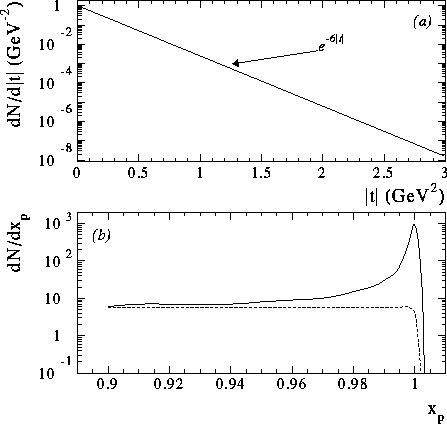Although rapidity gap studies can be used to gain some insight into the nature of the pomeron, these studies can be vastly improved through the addition of a Forward Proton Detector (FPD). Tagging the forward proton removes the ambiguity of a rapidity gap tag, which suffers from background due to low multiplicity non-diffractive events. This removes the need for fitting multiplicity distributions to determine the non-diffractive background (as shown in Fig. 3). The rapidity gap tag also does not give information on whether the scattered proton remains intact or is excited into a low-mass state, which could still yield a rapidity gap.
By detecting the scattered proton, one can measure its momentum (p) and thus
derive two key variables ![]() , the fractional
longitudinal momentum
of the scattered
proton, and
, the fractional
longitudinal momentum
of the scattered
proton, and ![]() , the four-momentum transfer to
the proton. Rapidity gap techniques do not give access to these
two variables and thus lose important information about the
diffractive process. The momentum fraction of the pomeron (
, the four-momentum transfer to
the proton. Rapidity gap techniques do not give access to these
two variables and thus lose important information about the
diffractive process. The momentum fraction of the pomeron (![]() )
is simply related
to the momentum fraction of the proton by
)
is simply related
to the momentum fraction of the proton by ![]() . A measurement of
the proton momentum thus gives the diffractive mass
. A measurement of
the proton momentum thus gives the diffractive mass ![]() through the
equation
through the
equation ![]() ,
where
,
where ![]() is the center-of-mass energy.
is the center-of-mass energy.

Figure 5: (a) A plot of dN/d![]() which is a good approximation
to the |t| distribution for single diffraction.
(b) The solid curve shows an approximation to the
which is a good approximation
to the |t| distribution for single diffraction.
(b) The solid curve shows an approximation to the ![]() dependence
of CDF single diffractive
data. The dashed curve shows an estimate of the
non-pomeron exchange background.
dependence
of CDF single diffractive
data. The dashed curve shows an estimate of the
non-pomeron exchange background.
Figure 5(a) shows the |t|-dependence
of single diffraction, which has been measured to be
![]() , where
, where ![]() for single diffraction
at
for single diffraction
at ![]() GeV [21].
The exact slope has a mild dependence
on
GeV [21].
The exact slope has a mild dependence
on ![]() and
and ![]() . For elastic scattering, the cross section
drops even more steeply with
. For elastic scattering, the cross section
drops even more steeply with ![]() [22].
Figure 5(b) shows the
[22].
Figure 5(b) shows the ![]() dependence of diffraction, where
the curves are approximations to the
dependence of diffraction, where
the curves are approximations to the
![]() GeV
data in Ref. [21]. The
solid curve is sharply peaked at
GeV
data in Ref. [21]. The
solid curve is sharply peaked at ![]() (the beam energy), with some
smearing due to the 0.1% momentum resolution and a tail to higher
(the beam energy), with some
smearing due to the 0.1% momentum resolution and a tail to higher ![]() values (the distribution for elastic scattering does
not have the higher
values (the distribution for elastic scattering does
not have the higher ![]() tail). The dashed curve is an
estimate of the non-pomeron exchange background.
Pomeron exchange is typically assumed to
dominate over other exchanges in the region where
tail). The dashed curve is an
estimate of the non-pomeron exchange background.
Pomeron exchange is typically assumed to
dominate over other exchanges in the region where
![]() (
(![]() ), which implies a maximum mass of
), which implies a maximum mass of
![]() GeV/
GeV/![]() for the Tevatron in Run II
(
for the Tevatron in Run II
(![]() GeV).
GeV).
The ability to obtain large data samples and divide the data into mass bins facilitates the comparison of the data with theory in the form of phenomenological Monte Carlos, and allows studies of the pomeron structure in the pomeron-proton center-of-mass.